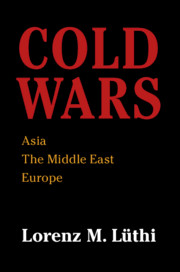Book contents
- Cold Wars
- Cold Wars
- Copyright page
- Dedication
- Contents
- Maps
- Acknowledgments
- Note on Names, Transliterations, and References
- Abbreviations
- Introduction
- 1 From High Imperialism to Cold War Division
- Part I Elusive Unities
- Part II Asia
- Introduction to Chapters 5 to 7
- 5 China
- 6 Vietnam
- 7 India
- Part III The Middle East
- Part IV Alternative World Visions
- Part V Europe between the Superpowers
- Part VI European Détente
- Part VII The End of the Regional Cold Wars
- Notes
- Index
6 - Vietnam
from Part II - Asia
Published online by Cambridge University Press: 19 March 2020
- Cold Wars
- Cold Wars
- Copyright page
- Dedication
- Contents
- Maps
- Acknowledgments
- Note on Names, Transliterations, and References
- Abbreviations
- Introduction
- 1 From High Imperialism to Cold War Division
- Part I Elusive Unities
- Part II Asia
- Introduction to Chapters 5 to 7
- 5 China
- 6 Vietnam
- 7 India
- Part III The Middle East
- Part IV Alternative World Visions
- Part V Europe between the Superpowers
- Part VI European Détente
- Part VII The End of the Regional Cold Wars
- Notes
- Index
Summary
One of the most divisive conflicts of the Cold War, the confrontation in Indochina was primarily fueled by the Vietnamese communist pursuit of national liberation, control over Indochina, and world revolution. Starting as an anti-colonial struggle in the interwar period, it turned into a Cold War clash by 1950. Over the course of three decades after 1945, the Vietnamese communist leadership led the fight against imperial France and the United States, but also against political rivals among non-Communist nationalists and members of the party. In the process, it eliminated political alternatives and created a political monoculture . Its ultimate goal was to establish a socialism Vietnam, Indochina, and ultimately all of Southeast Asia. The long duration of the conflict and the extraordinary stability of the communist leadership gradually created a militarized and rigid communist state that sought maximalist goals on the battlefield and in diplomacy. Its radical goals not only went well far beyond national liberation but also demanded extraordinary sacrifices from the population. Only Sino-American rapprochement by the late 1970s managed to contain Vietnamese Communist radicalism.
- Type
- Chapter
- Information
- Cold WarsAsia, the Middle East, Europe, pp. 138 - 161Publisher: Cambridge University PressPrint publication year: 2020

